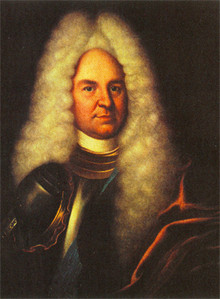Patrick Gordon
As opportunities for military employment dried up in the Three Kingdoms, the Netherlands and Scandinavia in the 1650s and 1660s, soldiers of fortune from the British Isles were driven to look further afield. As Muscovy opened a window on the west and sought to modernize, Scottish and other foreign officers were useful in importing and introducing western European weapons, tactics and discipline. They were also frequently employed as diplomats, as they had been earlier in Sweden and Denmark-Norway. Patrick Gordon of Auchleuchries and Paul Menzies, both Catholics, were especially useful in this regard. The latter was sent on a diplomatic mission to the pope in 1672 to improve relations with Rome and to attempt to secure papal approbation for a crusade against the Crimean Tatars and the Ottoman Turks. Patrick Gordon was successful in persuading Czars Ivan and Peter to grant permission to build a Catholic Church in Moscow, staffed with priests, where they allowed freedom of worship to soldiers from western Europe. At the same time, soldiers of fortune serving abroad were useful sources of information and constituted a kind of informal intelligence network for the rulers of their native countries. Patrick Gordon, who served in the armies of Sweden, Poland and Russia, kept up a correspondence with the second earl of Middleton and Sir Joseph Williamson, who was secretary to the earl of Arlington. Thus, the English government was kept informed about military and foreign affairs in Russia, Ukraine, Poland and on the borders of the Ottoman empire.
Patrick Gordon was a well travelled soldier of considerable experience. He was articulate, observant and left a most valuable memoir. Soon after joining the Swedish army in 1655 he was captured by the Poles; a Scots Franciscan named Innes obtained his release on condition that he joined the Polish army. Gordon was then recaptured by the Swedes. He was taken before a fellow Scot, Lieutenant Field Marshal Robert Douglas, who accepted Gordon’s explanation of how he came to be in the Polish force, and enlisted him for three years service in the Swedish army. Gordon was assigned to Douglas’s own company of Scottish cadets and sent back to Warsaw to recruit Scottish prisoners of war for Douglas’s company. He returned with twenty-four recruits. The captain-lieutenant of Gordon’s company was John Meldrum, and the troops were employed in cattle-raiding. Since they were very good at this (being Scots), Gordon had soon earned 100 Reichsthalers and acquired a pair of good horses. He was bothered by these practices, but remembered that the Swedish army lived off the land, and this was what one had to do to survive. After being taken prisoner by the Imperial Austrian army, Gordon escaped and made his way back to the Swedish camp. He demanded to be discharged, on the pretext that he had never been paid or reimbursed for his equipment. Soldiers in the Swedish army at this time were expected to live by plunder. For a time Gordon joined a band of Scottish freebooters, who specialized in capturing Austrians and selling them to the Swedish army. In 1658 he once again joined the Swedish army as an ensign, and was assigned to Colonel Anderson’s regiment. Captured again by the Poles, he was assigned to a cavalry regiment. Gordon was by now an experienced soldier with the rank of captain-lieutenant, and found himself courted by the Poles, the Muscovites and the Imperialists. He was about to join an Austrian cavalry regiment commanded by a distant kinsman, Colonel Patrick Gordon of the Steelhand, but the regiment was never raised. With the conclusion of peace between the Holy Roman Empire and Ottoman Turkey, he was persuaded to join the Russian army.
The Scots abroad maintained a kind of freemasonry among themselves, whatever army they served in. While travelling to Prague with a group of fellow Scots, Gordon learned that Scots were being discharged from the Swedish army and that better opportunities were to be found in Russian service. He and seven fellow Scots decided to set out for Moscow. He was commissioned a major, but had trouble get- ting the scribe to deliver his commission until he paid a large bribe. Gordon was always troubled by the bribery and extortion, which were part of the fabric of Russian life. He was posted to a regiment commanded by Daniel Crawford and officered entirely by Scots, but made up of 700 mutinous Russians, all deserters from other regiments. As the major, Gordon was expected to drill and discipline them. Since foreign officers were not permitted to marry Russian women unless they converted to the Russian Orthodox Church, Gordon fixed upon Katharine von Bockhoven, the 16-year-old Catholic daughter of a colonel in the Russian army.
Service under the czars always raised the problem of conflicting allegiances. Gordon did well in the Russian army, and by 1686 was a lieutenant-general and commander of the Kiev garrison. However, he was homesick and sought release from Russian service. Despite the personal intervention of James VII and II, arranged by his friend the earl of Middleton, he was unable to secure a discharge. He was allowed to return to Scotland for a period of three months to settle family business, but was obliged to leave his wife and family behind as pledges for his return. Indeed, he was in temporary disgrace for attempting to resign, and was threatened with demotion to the rank of ensign and banishment to some remote place. Gordon redeemed himself only by admitting his error and craving pardon. He regarded all of these histrionics as a ‘stage play’. Most Scots found it difficult to leave the czar’s service, and left numerous descendants who subsequently became russified.
